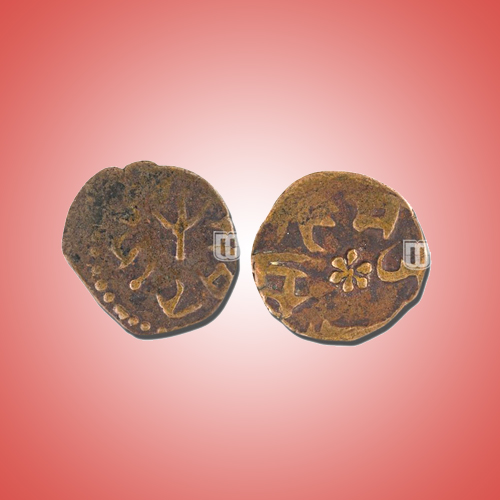Six-pointed Star and Sword on Sitamau’s Coin
2022-05-02 Mon
The chief of Sitamau belongs to Rathore Rajput of the Jodhpur family and had nexus with the Rajas of Ratlam and Sailana. It was founded by Kesho Das, grandson of Ratan Singh from Ratlam who received Titroda, Nahargarh, and Parganas from Aurangzeb in 1695. Of these, Nahargarh and Parganas were seized by the chiefs of Gwalior and Dewas respectively. Sitamau princely state was situated on the south-western plateau of Malwa.The total covered area was 523 square kilometers. It was founded by a Meena chief, Sataji on which state name was kept. The boundaries of the state touched Indore and Gwalior on the northern side, Jaora and Dewas on the south, Jhalawar state of Rajputana in the east, and on the west side by Gwalior. The principal river of the state was Chambal which forms the eastern boundary and was used as a source for irrigation.
An adjoined image is of copper paisa of Sitamau princely state. Bahadur Shah issued this type of coin in 1944 [VS] Vikram Samvat. The obverse of the coin features Trident in the center, VS date, Devanagari legend, and imprint on the backside of the coin is Mint name in Devanagari, Six-pointed star and Sword.
Image Courtesy: Mintage World
Latest News
-
Malwa Sultan Mahmud Shah Silver Coins
2025-09-11 ThuMalwa Sultan Mahmud Shah minted silver coins in round and square flans. <br><br> For round coins,...
-
Malwa Sultan Mahmud Shah Billon coin
2025-08-26 TueMalwa Sultan Mahmud Shah's billon coins followed three weight standards: 100 rati, 96 rati, and 80 r...
-
Fascinating Archaeological Facts on Postage Stamps - 91
2025-08-23 SatRhinoceros is one of the oldest land mammal species existing in India. There are five species of rhi...
-
Fascinating Archaeological Facts on Postage Stamps - 90
2025-08-23 SatUthiramerur, a Village in Kanchipuram, Tamil Nadu, is notable for its Temple inscriptions that descr...
-
Fascinating Archaeological Facts on Postage Stamps - 89
2025-08-21 ThuThe term “millet” is derived from the Latin word “milum,” which translates to grain. millets...

